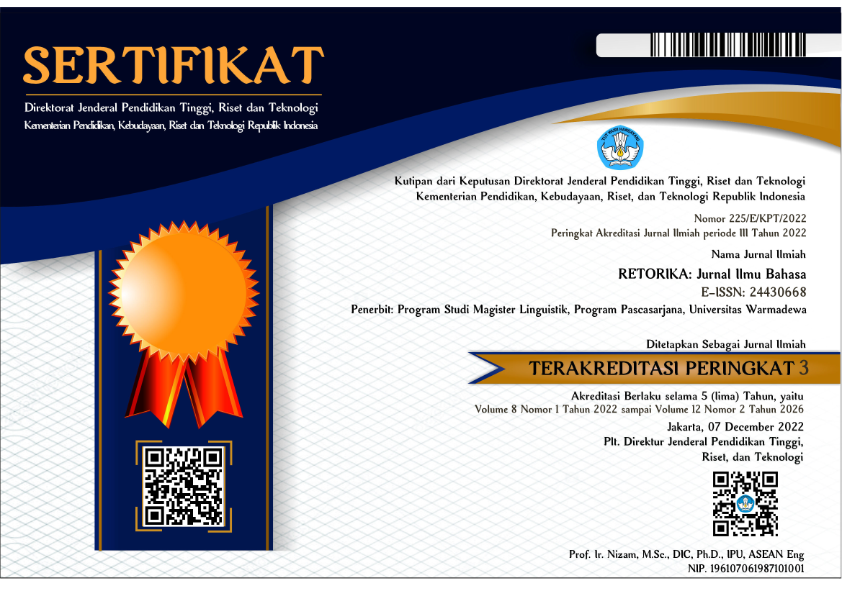Interpersonal and Ideational Metaphors in the Writing of Thesis Texts of Undergraduate Students of English Study Program: A Systemic Functional Linguistic Approach
Abstract
This study describes how interpersonal and ideational metaphors were realised in th writing of theses texts written by undergraduate students of English study program. This study is a documentary analysis of descriptive method. Data in the form of corpus data were randomly taken from 15 theses among 70 theses in population. Data were analyzed by focusing on the semantic functions covering interpersonal and ideational metaphors. The results showed that interpersonal metaphor was realised in mood system and modality. Mood system was realised mostly in declarative clauses than interrogative and imperative ones. This fact was caused by the channel of text, written text. Modality was least used in the texts. Ideational metaphor was sin transitivity system in which material process was mostly applied than mental, behaviour, existential, relational and verbal processes. Nominalisation was selected as the mostly used property of linguistic feature in writing theses. Ideational metaphor was more used than interpersonal metaphor. This fact happens due to the text channel, written text. Therefore, it is suggested that lecturers in their teaching should consider their teaching by including metaphorical meaning, especially ideational and interpersonal metaphors. Besides, it is suggested to conduct research by comparing languages, national or international languages such as between Indonesian and English or else.
References
Brown.G, & Yule, G. (1983). Discourse Analysis. Cambridge University Press.
Eggins, S. (1994). An Introduction to Systemic Functional Linguistics. Pinter Publishers.
Ezeifeka R., C. (2015). Grammatical Metaphor: In Search of Proficency in Research Abstract Writing. Sage Jurnal.
Halliday, M. A. K. (1985a). An Introduction to Functional Grammar. Edward Arnold.
Halliday, M. A. K. (1994a). An Introduction to Functional Grammar (2nd ed.). Edward Arnold.
Halliday, M. A. K, & Matthiessen, C. (2014a). An Introduction to Functional Grammar (3rd ed.). Hodder Arnold.
Halliday, M. A. K. (1985b). An Introduction to Functional Grammar. Edward Arnold.
Halliday, M. A. K. (1994b). An Introduction to Functional Grammar. Edward Arnold.
Halliday, M. A. K. (1998). Things and Relations: Regrammaticising experience as technical knowledge. In Reading Science: Critical and Functional Perspectives on Discourses of Sciences.
Halliday, M. A. K. (1995). On Language in Relation to the Evolution of Human Consciousness. Of Thoughts and Words (Proceedings of Nobel Symposium 92: The Relation between Language and Mind), 45–84.
Halliday, M. A. K., & Matthiessen, C. M. I. M. (1999). Construing Experience Through Meaning: A Language-based Approach to Cognition (OpenLlinguisticsSseries). Continuum.
Halliday, M. A. K., & Matthiessen, C. M. I. M. (2004). An Introduction to Functional Grammar (3rd ed.). Hodder Arnold.
Halliday, M. A. K., & Matthiessen, C. M. I. M. (2014b). Halliday’s Introduction to Functional Grammar. Routledge.
Kaneso, Y. (2016). Ideational Grammatical Metaphorical Features of EFL Textbooks [Marshall University].
Lakoff, G., & Johnson, M. (1980). Metaphors We Live By (1st ed.). University of Chicago Press.
Lau, Y. L. (2009). Kajian Metafora Kata Nama dan Kata Sifat dalam Cerpen Bahasa Mandarin [Universiti Malaya].
Mahsun. (2007). Metode Penelitian Bahasa. PT Raja Grafindo Persada.
Matthiessen, C. M. I. M. (1995). Lexicogrammatical Cartography: English SystemsInternational. Language Sciences Publisher.
Ngongo, M. (2016). Systemic Analysis of Text Appraisal on Students’ Thesis writing in English. Journal of Scientific Research and Studies, 7(4), 67–72.
Ngongo, M. (2015). Analisis Sistemik Metafora Gramatika dalam Teks Bahasa Waijewa. In I. A. M. Puspani & Dkk. (Eds.), Strategi Pemberdayaan Bahasa Lokal demi Pelestarian Budaya Bangsa dan Upaya Penguatan Jati Diri (pp. 633–642). Udayana University Press.
Seyedvalilu, S., & Ghafoori, N. (2016). Ideational Grammatical Metaphor in Merry Shelly’s Frankenstein and its Cinematic Adaptation. The Journal of Applied Linguistics, 9(19), 141–160.
Taverniers, M., & Ravelli, L. J. (2003). Grammatical Metaphor in SFL: A Historiography of the Introduction and Initial Study of the Concept. In A.-M. Simon-Vandenbergen & L. J. Ravelli (Eds.), Grammatical Metaphor: Views from Systemic Functional Linguistics (1st ed., pp. 5–33). John Benjamins Publishing Company.
To, V., & Thomas, D. (2017). Examining Interpersonal Metaphor of Modality in Successful Primary Persuasive Texts. In P. Chappell & J. S. Knox (Eds.), Transforming texts: Proceedings of the 44th International Systemic Functional Linguistics Congress (pp. 1–6). The Organising Committee of the 44th International Systemic Functional Congres.
Copyright (c) 2020 RETORIKA: Jurnal Ilmu Bahasa

This work is licensed under a Creative Commons Attribution-ShareAlike 4.0 International License.
This journal provides immediate open access to its content on the principle that making research freely available to the public supports a greater global exchange of knowledge.
All articles published Open Access will be immediately and permanently free for everyone to read and download. We are continuously working with our author communities to select the best choice of license options, currently being defined for this journal as follows: Creative Commons-Non Ceomercial-Attribution-ShareAlike (CC BY-NC-SA)
 Abstract viewed = 1486 times
Abstract viewed = 1486 times
 PDF downloaded = 1694 times
PDF downloaded = 1694 times

2.png)














